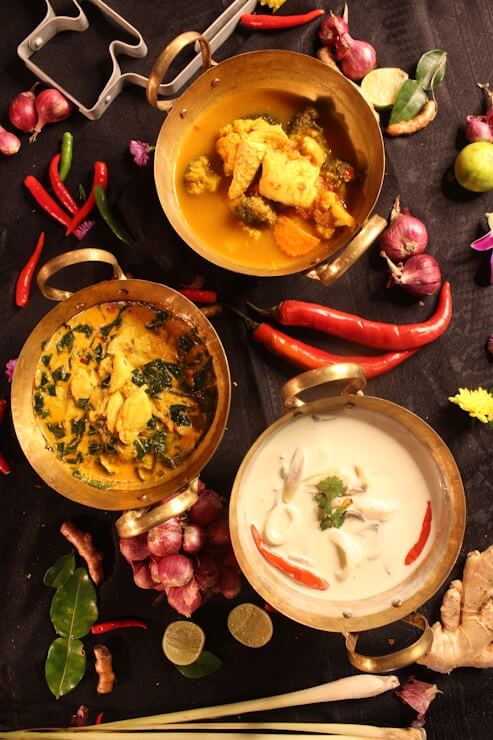If you crave vibrant, wholesome, and flavorful vegetarian dishes, Maharashtrian cuisine offers a treasure trove of recipes that celebrate the richness of local vegetables, spices, and traditional cooking methods.
From tangy and spicy curries to comforting snacks and subtly sweet treats, Maharashtrian food boasts a perfect balance of tastes that can invigorate your everyday meals.
Whether you are a seasoned cook or a beginner looking to explore regional Indian flavors, these veg Maharashtrian recipes will delight your taste buds and nourish your body.
In this blog post, we dive deep into some classic vegetarian dishes from Maharashtra, highlighting their unique ingredients and step-by-step preparation.
These recipes are easy to follow and use readily available ingredients, making it simple for you to bring the essence of Maharashtra into your kitchen.
Let’s embark on this culinary journey together and discover why Maharashtrian vegetarian food is both comforting and exciting!
Why You’ll Love This Recipe
Maharashtrian vegetarian recipes stand out because of their harmonious blend of flavors — sweet, sour, spicy, and savory — often balanced with the addition of jaggery, tamarind, and freshly ground spices.
These dishes are not only delicious but also nutritious, incorporating a variety of fresh vegetables, legumes, and leafy greens.
Why choose Maharashtrian veg recipes?
- They use simple, wholesome ingredients that are easy to find.
- The recipes are versatile and can be adapted to suit your spice preference.
- They offer a delightful mix of textures and flavors, from crunchy to creamy.
- These dishes are perfect for family meals, festivals, or casual gatherings.
Plus, learning these recipes opens doors to exploring other regional Indian cuisines. If you enjoy this, you might love trying the All American Chili Recipe Cooking Light or the delicious Almond Cake And Pastry Filling Recipes for your next culinary adventure!
Ingredients
| Ingredient | Quantity | Notes |
|---|---|---|
| Vegetables (mixed seasonal veggies) | 3 cups | Carrots, beans, peas, potatoes |
| Onion | 1 medium | Finely chopped |
| Tomato | 2 medium | Pureed |
| Green chilies | 2 | Slit or chopped |
| Mustard seeds | 1 tsp | For tempering |
| Cumin seeds | 1 tsp | For tempering |
| Asafoetida (Hing) | 1/4 tsp | Enhances flavor |
| Turmeric powder | 1/2 tsp | Color and health benefits |
| Coriander powder | 1 tsp | Ground fresh if possible |
| Red chili powder | 1/2 tsp | Adjust to taste |
| Tamarind paste | 1 tbsp | Provides tang |
| Jaggery (grated) | 1 tsp | Balances sourness |
| Fresh coriander leaves | 2 tbsp | Chopped, for garnish |
| Salt | To taste | – |
| Cooking oil | 2 tbsp | Preferably peanut or sunflower oil |
Equipment
- Heavy-bottomed pan or kadai
- Mixing bowl
- Spatula or wooden spoon
- Knife and chopping board
- Measuring spoons and cups
- Blender or grinder (for tomato puree)
Instructions
- Prepare your vegetables: Wash and chop all vegetables into bite-sized pieces. Set aside.
- Make the tomato puree: Blend the tomatoes until smooth and keep aside.
- Heat oil: In a heavy-bottomed pan, heat 2 tablespoons of oil on medium heat. Add mustard seeds and wait until they start to crackle.
- Add cumin seeds and asafoetida: Stir quickly to release their aroma without burning.
- Sauté onions and green chilies: Add finely chopped onions and green chilies. Cook until onions turn translucent and slightly golden.
- Add spices: Stir in turmeric powder, coriander powder, and red chili powder. Cook for about 30 seconds to bloom the spices.
- Add tomato puree: Pour in the fresh tomato puree and cook until the oil separates from the masala, stirring occasionally (about 6-8 minutes).
- Add vegetables and salt: Mix in the chopped vegetables and salt. Stir well to coat them with the masala.
- Cook with water: Add about 1 cup of water to the pan, cover, and simmer for 15-20 minutes or until the vegetables are tender.
- Add tamarind paste and jaggery: Stir in tamarind paste and grated jaggery. Adjust salt and spice levels. Cook for another 5 minutes to blend the flavors.
- Garnish: Turn off the heat and sprinkle chopped fresh coriander leaves.
- Serve hot: Your authentic veg Maharashtrian dish is now ready to be enjoyed.
Tips & Variations
“For an extra layer of flavor, roast your coriander and cumin seeds before grinding your own spice powders.”
To adjust the recipe to your liking, you can swap vegetables based on seasonality or preference. For example, add drumsticks (moringa), snake gourd, or even raw banana for a true Maharashtrian touch.
If you prefer a thicker curry, reduce the amount of water or add a spoonful of roasted gram flour (besan) towards the end of cooking. For a lighter, soup-like consistency, increase the water and serve with steamed rice or bhakri.
To try something different, you might want to explore other Indian vegetarian dishes like the Allens Green Beans Recipe or the comforting Baiao De Dois Recipe: A Taste of Brazilian Comfort for variety.
Nutrition Facts
| Nutrient | Per Serving (Approx.) |
|---|---|
| Calories | 150 kcal |
| Carbohydrates | 25 g |
| Protein | 4 g |
| Fat | 5 g |
| Fiber | 6 g |
| Sugar | 4 g (natural from vegetables and jaggery) |
| Sodium | 350 mg (adjust according to salt) |
| Vitamin C | 30% DV |
Serving Suggestions
This flavorful Maharashtrian vegetable curry pairs wonderfully with steamed basmati rice or traditional Indian flatbreads like bhakri or chapati. For a festive meal, serve alongside puran poli or batata bhaji for a complete Maharashtrian spread.
Adding a dollop of yogurt or a side of koshimbir (a fresh vegetable salad) can balance the spices and add refreshing contrast. For a crunchy accompaniment, try fried papad or roasted peanuts.
Looking for a dessert to round off your meal? Check out the luscious Baileys Whipped Cream Recipe: A Delicious Topping — it’s a perfect indulgence after a spicy feast.
Conclusion
Veg Maharashtrian recipes bring a delightful fusion of flavors, textures, and colors to your dining table. Their unique use of local ingredients like jaggery and tamarind, combined with simple cooking techniques, makes them accessible and enjoyable for cooks of all skill levels.
These dishes not only satisfy your palate but also nourish your body with fresh vegetables and spices.
Whether you are cooking for your family or entertaining guests, these recipes offer a wonderful way to experience the heart of Maharashtra’s culinary heritage. Feel free to experiment with the ingredients and find your personal favorite variations.
And when you’re ready for your next cooking project, don’t forget to explore some other exciting recipes like Almond Cashew Clusters Recipe for a wholesome snack or Alloco Recipe for a crispy treat.
Happy cooking and enjoy the rich, vibrant tastes of Maharashtrian vegetarian cuisine!
📖 Recipe Card: Batata Vada
Description: A popular Maharashtrian snack made with spicy mashed potatoes coated in gram flour batter and deep-fried to golden perfection. Crispy on the outside and soft inside, it’s perfect for tea-time or a quick snack.
Prep Time: PT20M
Cook Time: PT25M
Total Time: PT45M
Servings: 6 servings
Ingredients
- 4 medium potatoes, boiled and mashed
- 2 green chilies, finely chopped
- 1 tsp mustard seeds
- 1 tsp turmeric powder
- 1 tsp ginger-garlic paste
- 10 curry leaves
- 1 cup gram flour (besan)
- 1/2 tsp red chili powder
- 1/4 tsp asafoetida (hing)
- Salt to taste
- Water as needed
- Oil for deep frying
Instructions
- Heat oil in a pan, add mustard seeds and curry leaves.
- Add green chilies and ginger-garlic paste, sauté for a minute.
- Add turmeric powder and mashed potatoes, mix well.
- Cook for 5 minutes, then remove and let it cool.
- Mix salt into the potato mixture and shape into small balls.
- Prepare batter by mixing gram flour, red chili powder, asafoetida, salt, and water to a smooth consistency.
- Heat oil in a deep pan.
- Dip each potato ball into the batter and deep fry until golden brown.
- Drain on paper towels and serve hot with chutney.
Nutrition: Calories: 250 kcal | Protein: 6 g | Fat: 14 g | Carbs: 25 g

